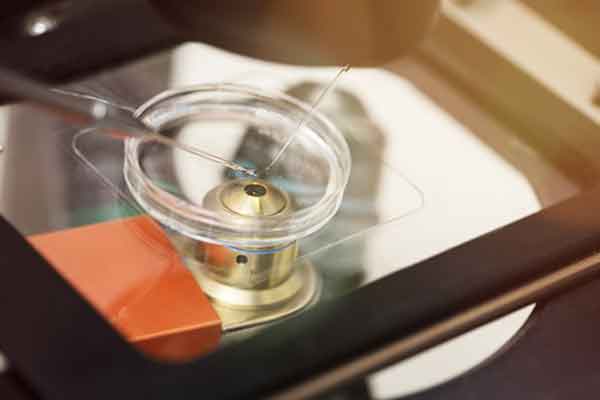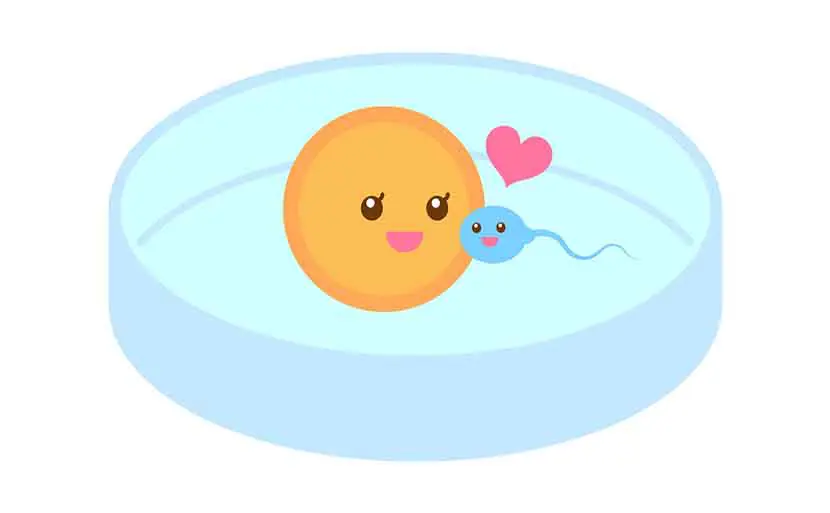- What is IVF?
- What is an IVF schedule?
- What is the success rate of IVF pregnancy?
- Are there risks associated with IVF?
- What are the costs of IVF?
- Where do people get IVF?
- Is there an age limit for IVF?
- If IVF is successful
- What are the benefits of NIPT after IVF pregnancy?
- Amniotic fluid testing (definitive)
- Chorionic villus testing (definitive)
- What is a maternal serum marker?
- NIPT
- Highly accurate NIPT with minimal impact on mother and foetus
- Effects of IVF stress on mother and foetus
- IVF is not associated with the incidence of chromosomal abnormalities
- Hiro Clinic NIPT can perform NIPT on twins
- Fertility treatment is covered by public medical insurance
- Hiro Clinic NIPT’s choice of NIPT plans
- In case of a positive diagnosis by NIPT
- Summary
What is IVF?
In vitro fertilisation is a type of fertility treatment in which an egg is removed from the body just before ovulation and fertilised with sperm outside the body.
In the first place, infertility treatment involves testing and, once the cause has been identified, treating the disease that is causing the problem.
This is followed by ‘artificial insemination’, ‘in vitro fertilisation’, ‘intracytoplasmic fertilisation’ and ‘treatment for men’.

What is an IVF schedule?
‘Do I have to go through IVF more than once?’ Many people wonder.
Let’s take a look at how the IVF schedule works.
As it turns out, it takes about one to two months from the time you decide to do IVF to the time you become pregnant. However, the period may be extended further if the first egg retrieval and embryo transfer fails to result in pregnancy.
The six basic steps are as follows.
- Stimulate ovulation
- Oocyte collection
- In vitro fertilization
- Cultivate
- Embryo transfer
- Pregnancy test
1.Stimulate ovulation
Around the third to tenth day of menstruation, medication is used to stimulate ovulation.
Ovulation induction methods include ‘complete natural ovulation cycle’, ‘low stimulation’, ‘medium stimulation’ and ‘high stimulation’, and it is believed that ovulation induction drugs are used according to the examination of each individual’s ovaries.
2.Oocyte collection
The oocytes are collected around the 11th to 14th day of menstruation.
Under ultrasound guidance, a special needle called an oocyte collection needle is inserted into the vagina and punctures the ovary to collect the oocytes.
In many cases, depending on the thickness of the oocyte collection needle, this may cause pain. Anaesthesia can be used to reduce the pain caused by the needle puncture, so those who are sensitive to pain should consult their doctor beforehand.
During the oocyte retrieval, the partner will collect the semen in a separate room.
3.In vitro fertilization
There are four fertilisation methods: ‘Conventional IVF’, ‘Rescue ICSI’, ‘ICSI’ and ‘Split ICSI’.
Each has its own advantages and disadvantages and costs differ, but usually the ‘Conventional IVF’ method is used for natural fertilisation.
The fertilised egg then undergoes cell division and becomes an ’embryo’.
The embryo grows through further cell division.
4.Cultivate
After IVF, the embryos are cultured in an incubator for 2-6 days.
After a diagnosis of the type of ovarian stimulation method, hormone levels and endometrial thickness, embryo transfer takes place in the cycle in which the oocytes were collected.
5.Embryo transfer
The embryo is transferred into the uterus by advancing an embryo transfer catheter into the uterine cavity.
Embryo transfer may use fresh embryos (split-stage embryos or blastocysts) from the cycle in which the eggs were collected, or embryos that have been frozen and thawed (split-stage embryos or blastocysts).
Embryo transfer leads to pregnancy.
6.Pregnancy test
Seven to ten days after the embryo transfer, the pregnancy is finally determined.
A blood sample is taken to measure the hCG hormone, which increases with pregnancy, to confirm that the woman is pregnant.
What is the success rate of IVF pregnancy?
What is of concern at this point is the IVF pregnancy success rate.
Looking at the 2018 Japan Society of Obstetrics and Gynaecology announcement by age, the production rate (birth rate) per embryo transfer is 34% at age 30, 30% at age 35, 17% at age 40 and 2.8% at age 45, showing that as age advances, the production rate decreases.
This is said to be because the number of eggs decreases with increasing age and the quality of the eggs declines, causing chromosomal abnormalities in the baby.
These factors halve the pregnancy success rate with IVF when comparing women in their early 30s with those in their late 30s and 40s. To increase the pregnancy success rate, it is advisable to consider IVF as early as possible.

Are there risks associated with IVF?
The next concern is the risks associated with IVF.
‘How old do I have to be to have it?’ Many people wonder.
The risks of IVF include the risks and side effects of ovarian induction drugs (e.g. drugs that stimulate the ovaries and ovulation).
It is also said that the use of medicines can reduce ovarian function, but these risks are minimal if the medicines are taken as directed by a doctor.
The type of medication, dosage and timing of administration will be done by your doctor and you should follow his or her instructions.
What are the costs of IVF?
According to a survey by the Ministry of Health, Labour and Welfare (MHLW), the average cost of a single IVF session is announced at approximately JPY 500,000.
The reason for the high cost is that, with the exception of special exceptions, the treatment costs for IVF are not covered by insurance and must be paid in full.
※Fertility treatment to be covered by insurance in 2022
The cost of IVF varies from medical institution to medical institution, so check in advance with the medical institution performing the IVF/embryo transfer.
In addition, there is a government subsidy system for such high treatment costs, which can reduce the cost of one IVF treatment to several tens of thousands of yen. Inquire about the necessary costs at the contact point of the medical institution where IVF is carried out.
So what exactly are the government subsidy schemes and how many subsidies are available?
The current subsidy system provides a subsidy of 300,000 yen per subsidy.
The number of subsidies is up to six per child (three for those under 40-43 years of age).
The eligible age group is the wife’s age (under 43).
A subsidy of 300,000 yen will considerably reduce the cost of IVF, thus lowering the hurdle to IVF.
Where do people get IVF?
So, can IVF be performed at any facility?
In fact, IVF can only be performed at ‘registered medical facilities for in vitro fertilisation and embryo transfer’.
The website of the Japan Society of Obstetrics and Gynaecology lists registered medical facilities in your area, so check in advance.
Is there an age limit for IVF?
There is no age limit for IVF. However, as mentioned earlier, the success rate of IVF decreases after the age of 30s.
Furthermore, the lower the pregnancy rate, the more it costs, so if you are suffering from infertility, you will need to make a decision sooner rather than later.
Treatment such as in vitro fertilisation and embryo transfer is called ‘Advanced Assisted Reproductive Technology’, or ‘ART’ for short.
According to the “2017 ART pregnancy rate” published by the Japanese Society of Obstetrics and Gynaecology, the pregnancy rate at age 30 is around 45%.
At age 40, it is around just over 25%.
At age 41, just under 25%.
At age 43, the probability is a whopping 15%, so early treatment will still increase the success rate of pregnancy.
If IVF is successful
Even after successful IVF and having the baby of their dreams, many mothers and their families are concerned about their baby’s congenital diseases and chromosomal abnormalities.
Until now, prenatal diagnosis of congenital diseases and chromosomal abnormalities in babies has been done by ‘amniofiltration’ and ‘chorionic villus examination’. However, there is a miscarriage risk of approximately 0.3% for amniotic fluid tests and 1% for chorionic villus tests.
To avoid these miscarriage risks, an increasing number of people are now opting for ‘NIPT’ which causes less damage to mother and foetus.
NIPT is a test to ‘check for chromosomal abnormalities in the foetus’ from blood taken from the mother.
By undergoing this, it is possible to know the condition of the baby to be born and to respond to any eventuality.
Compared to conventional blood-based prenatal diagnosis, the test has a higher sensitivity and specificity, and the test itself is more accurate.
What are the benefits of NIPT after IVF pregnancy?
NIPT is a test that uses a blood sample from the mother’s arm to detect chromosomal abnormalities in the baby. It does not involve needle puncture of the mother’s abdomen or transvaginal collection of chorionic villi tissue, as in conventional prenatal diagnostic tests such as amniotic fluid testing and chorionic villus examination. For these reasons, it can be said to be a highly safe test with very little direct invasion (damage) to the mother and baby.
Before NIPT, there was also a prenatal diagnosis called ‘maternal serum marker’, which tests for chromosomal abnormalities in the baby using only the mother’s blood.
Amniotic fluid testing (definitive)
●Weeks of testing:from 15-16 weeks’ gestation
●Method of examination:Cell collection by puncture from the maternal abdomen
●Target diseases:21 trisomy (Down syndrome)・18 trisomy (Edwards syndrome)・13 trisomy (Patou syndrome)・Turner syndrome (monosomy X)・Triple-X syndrome (trisomy X)・Kleinfelter syndrome, etc. Partial deletions/duplications
●Testing accuracy:Approx. 99%
Chorionic villus testing (definitive)
●Weeks of testing:From 10-13 weeks’ gestation
●Method of examination:Cell collection from the maternal abdomen by puncture or transvaginally
●Target diseases:21 trisomy (Down syndrome)・18 trisomy (Edwards syndrome)・13 trisomy (Patou syndrome)・Turner syndrome (monosomy X)・Triple-X syndrome (trisomy X)・Kleinfelter syndrome, etc. Partial deletions/duplications
●Testing accuracy:Approx. 99%
※Placental mosaicism may occur in about 1% of chorionic villus examinations
What is a maternal serum marker?
●Weeks of testing:From 15-16 weeks’ gestation
●Method of examination:Blood samples taken from the mother
●Target diseases:21 trisomy (Down syndrome)・18 trisomy (Edwards syndrome)・Neural tube closure (a type of congenital abnormality that occurs in the brain, spine and spinal cord)
●Testing accuracy (nonconfirmatory):Approx. 83%.
NIPT
●Weeks of testing:From 10 weeks’ gestation
●Method of examination:Blood samples taken from the mother
●Target diseases:21 trisomy (Down syndrome)・18 trisomy (Edwards syndrome)・13 trisomy (Patou syndrome)・Whole chromosome examination/sex chromosomes・Partial deletions/duplications
●Testing accuracy (nonconfirmatory):Approx. 99.1%
Highly accurate NIPT with minimal impact on mother and foetus
NIPT is much safer than conventional prenatal diagnostics and is a highly accurate test to determine the probability of chromosomal abnormalities.
Effects of IVF stress on mother and foetus
According to an environmental survey of women undergoing IVF (infertility treatment), approximately 67% of women said they felt stress about infertility treatment, with 90% reporting stress about the financial burden. The stress caused by IVF (infertility treatment) is of course not only the financial burden, but also the relationship with the partner and the understanding of the workplace.
The term “stress” is originally used in physics to refer to “the distortion of matter due to external forces”. Stress is also said to increase blood pressure, which can lead to hypertension, and even if pregnancy is achieved through IVF, it can lead to risks such as increased susceptibility to gestational hypertension and delayed foetal development due to lack of oxygen.
For these reasons, it is important to create an environment that is less stressful than before conception, and to lead a relaxed life in order to have a healthy pregnancy and delivery.
IVF is not associated with the incidence of chromosomal abnormalities
The history of in vitro fertilisation (assisted reproductive technology: ART) began in 1978. In the more than 40 years since then, medical technology for IVF embryo transfer has made remarkable progress. One of the issues that has been the subject of much debate during that time is the ‘effects of IVF on the chromosomes of the foetus’.
However, research to date has failed to show an increased risk of chromosomal abnormalities or congenital heart disease with IVF or other ART pregnancies when compared to natural pregnancies. There are many factors that cause chromosomal abnormalities and congenital heart disease in the foetus, but future research and medical developments will clarify many of these factors and improve implantation rates.
IVF (Assisted Reproductive Technology: ART) is not believed to have any effect on foetal chromosome aberrations or congenital heart disease. On the other hand, in vitro fertilisation in assisted reproductive treatment is more likely to result in multiple implantations and multiples, as multiple fertilised eggs are implanted in the uterus with the aim of increasing the pregnancy rate.
Hiro Clinic NIPT can perform NIPT on twins
Many do not accept NIPT for twins. And even if they do, NIPT for twins often only detects 21-trisomy (Down syndrome)・18-trisomy (Edwards syndrome)・13-trisomy (Patou syndrome).
Hiro Clinic NIPT places the highest value on the ‘mother’s and her family’s right to know’. For these reasons, NIPT for twins is also performed with full chromosome aneuploidy, full autosomal partial deletion or duplication testing.
Hiro Clinic NIPT also performs NIPT testing for vanishing twins, in which a foetus that has died early in pregnancy is absorbed into the uterus. If you have any questions about twins and vanishing twins, please contact Hiro Clinic NIPT staff or doctors.
Fertility treatment is covered by public medical insurance
Until now, infertility treatment (assisted reproductive treatment) was not covered by public health insurance except for those cases where the relationship between treatment and disease was clear and the safety and effectiveness of the treatment was proven, and all treatment was carried out at one’s own expense.
However, as part of the measures to combat the declining birthrate, the Cabinet decided in May 2020 that infertility treatment will be covered by insurance from 2022.
Until now, many people have said that they have been unable to undergo NIPT even if they wanted to, due to the heavy burden of expensive infertility treatment costs such as in vitro fertilisation. It is Hiro Clinic NIPT‘s hope that infertility treatment will be covered by insurance, the cost burden will be reduced, and as many people as possible will be able to undergo NIPT and have a healthier pregnancy and delivery of their child.
Hiro Clinic NIPT’s choice of NIPT plans
NIPT is generally expensive. However, Hiro Clinic NIPT offers a NIPT plan starting at JPY 48,800 (excluding tax) for those who have given up on the test because of the cost.
Hiro Clinic NIPT values “the mother’s and family’s right to know” above all else, and our unique NIPT plans are based on the vast amount of NIPT test data that has been carried out to date, and provides efficient and appropriate test content. Please contact Hiro Clinic NIPT to discuss your age and budget.
In case of a positive diagnosis by NIPT
At Hiro Clinic NIPT, many mothers become pregnant after IVF or other fertility treatments and undergo NIPT. However, if the NIPT is subsequently positive, a decision has to be made as to whether or not an amniotic fluid test, which is a definitive test, should be performed.
The amniotic fluid test is also not covered by insurance, which means that all the high costs are out-of-pocket. Starting from the cost of infertility treatment, the cost of amniotic fluid testing is too big a burden to bear.
Hiro Clinic NIPT offers an amniotic fluid test support system that subsidises the cost of an amniotic fluid test by up to JPY 200,000 (tax included). Hiro Clinic NIPT Amniotic Fluid Test Support System offers a highly efficient NIPT plan, with all appointments made online, and subsidised amniotic fluid testing costs. Hiro Clinic NIPT will sincerely answer any questions or concerns about NIPT so that as many mothers as possible can have a healthy birth day.
Summary
In this article, the steps and costs of IVF are explained.
IVF takes a lot of time and costs a lot of money, but it is a ray of hope for couples who wish to have children.
In addition, from 2022, infertility treatment, which was previously considered out-of-pocket, will be covered by insurance. Of course, infertility treatment, including in vitro fertilisation, can be a mental and physical burden. However, the long-awaited pregnancy and birth is an irreplaceable joy. Hiro Clinic NIPT will continue to provide better NIPT for the health of mothers and babies.
【References】
- Department of Obstetrics and Gynaecology, Showa Medical School – A study of psychosomatic characteristics in pregnant women who conceived by assisted reproductive technologies and underwent NIPT
- Osaka Cancer Cardiovascular Centre – Stress・More information
Article Editorial Supervisor

岡 博史先生
【役職】
【資格】
【略歴】
【所属】
【SNS】
 中文
中文






